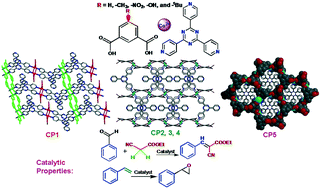Structural diversity and catalytic properties of five Co2(COO)4 cluster-based coordination polymers modified with R-isophthalic acid (R = H, NO2, CH3, OH and tBu)†
Abstract
The self-assembly of 5-substituted isophthalic acid (R-H2BDC, R = H, –NO2, –CH3, –OH and –tBu), CoII ions and 2,4,6-tris(4-pyridyl)-1,3,5-triazine (TPT) under solvothermal conditions yielded five Co-based coordination polymers (CPs): {[Co(BDC)(TPT)]·0.5(H2O)}n (CP1), {[Co(NO2-BDC)(TPT)]·H2O}n (CP2), {[Co(CH3-BDC)(TPT)]·0.5H2O}n (CP3), {[Co(HO-BDC)(TPT)]·0.5H2O}n (CP4), and {[Co(tBu-BDC)(TPT)2/3]·(CH3CH2OH)(H2O)}n (CP5) (H2BDC = isophthalic acid, NO2-BDC = 5-nitroisophthalic acid, CH3-BDC = 5-methylisophthalic acid, OH-BDC = 5-hydroxyisophthalic acid and tBu-BDC = 5-tert-butylisophthalic acid). All compounds comprise Co2(COO)4 binuclear units, which are connected via a combination of R-H2BDC and TPT ligands. In CP1, the binuclear Co2(COO)4 units are bridged into 1D chains extending along the [1 1 0] and [−1 1 0] directions, which are further interlinked by TPT ligands into a 3D network with CdS net topology. CP2, CP3 and CP4 are iso-structural and all exhibit 3D frameworks with pcu (α-Po) topology. In CP5, the Co2(COO)4 units are firstly linked into a 3D NbO net viatBu-BDC ligands, which are further accommodated by size-matching trigonal TPT ligands into a novel (3,8)-connected 3D net. Catalytic measurements show that CP2 and CP3 are good catalysts for the Knoevenagel condensation reaction of benzaldehyde with ethyl cyanoacetate, exhibiting conversions of 91.3% and 96.6% in 120 min, respectively, compared with the other present compounds. In addition, CP2 and CP5 exhibit highly efficient catalytic properties for the selective epoxidation of styrene.



 Please wait while we load your content...
Please wait while we load your content...